Chapter 1. Before the Fur Trade |
|
| | As the last great ice sheet covering the northern half of the North American continent melted, an abrupt and dramatic series of events east of the Rocky Mountains created the river valley that would provide a home for the succession of communities that became Edmonton. As the glaciers melted, the water formed a large, shallow lake behind enormous ice dams. The clay layer that built up on the lake bottom is familiar to all Edmonton gardeners. In a few places, sand deposits created low hills known to geologists as kames. Then around 12000 years ago, water began to erode the ice barrier on the southern shore of the lake. Once the water began to flow, the ice dam disappeared in a matter of days. The lake emptied out in a single massive event, carving a valley known as the Gwynne Outlet, east of the present town of Leduc. |
|
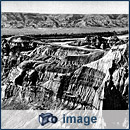
| | As soon as the lake vanished, the river that came to be known as the North Saskatchewan began carving through the soft sediments of the lake bed and into the firmer layers below. Within 3000 years, an amazingly short period in geological time, the river valley had reached its present depth and approximate course. Animals were quickly attracted to the shelter and richer vegetation of the river terraces as the presence of bones and wood dated to 8000BP from the flood plain attests. Before long, humans followed. |
|
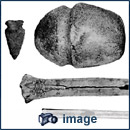
| | An archaeological site on Rabbit Hill, one of the glacial kames at a bend in the river, has yielded artefacts 5000 years old. At this time, climatic conditions were such that the great grasslands of the central North American interior stretched well beyond the North Saskatchewan river. The people who left their arrow and spear points in the sandy soil of Rabbit Hill were undoubtedly buffalo hunters who found the site a useful place to watch for herds making their way to the water. The river valley gravels also yielded a plentiful supply of quartzite and chert pebbles for tool manufacture. A large deposit of these stones on the river bank across from Rundle Park formed the basis for a major tool manufacturing site for several thousand years. |
|


| | The retreat of the great ice sheets produced a warming climate until about 4000 years ago when, for reasons that are not at all clear, it began to cool once again. The cooler climate pushed the edge of the grasslands well south of the North Saskatchewan Valley by 1000 BP, placing the region in the parkland vegetation zone where it remains to this day. Edmonton's location in this rather narrow transitional zone between the vast boreal forests to the north and the great plains to the south would be of great importance for its first century as a permanent settlement. It would also play a crucial role in the seasonal cycle of the bison, drawing the herds north for shelter in the winter and with them the hunters whose way of life depended on the great beasts. |
|
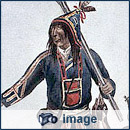
| | Just how these hunters were related to the present First Nations is not apparent until the late 18th century when the first European fur traders began to make their way up the waterways that led west to the Rockies. By that time the dominant people along the upper reaches of the North Saskatchewan were the Blackfoot (Siksika). How long this had been the case is not at all clear because power balances among the nations of the north western plains had been in a rapidly shifting state for at least a century. The introduction of horses from the Spanish settlements in Mexico had revolutionized the bison hunt and made the Blackfoot wealthy and powerful. Their increased strength allowed them to push their northern neighbours back into the boreal forests. |
|

| | Not long after horses began to have their impact, firearms began to affect the region. The Cree around Hudson Bay were the first to obtain guns in quantity. This not only gave them an edge in warfare but enabled them to occupy a profitable position as middlemen between the European traders and the nations of the interior. By the middle of the 18th century they were moving west and south onto the plains, acquiring horses and taking up the bison hunt. In Edmonton's first few decades as a fur trade post, the traders maintained as best they could a position of uneasy neutrality among these powerful opponents. |
Chapter 2. Fur Trade Hub, 1795-1869 |
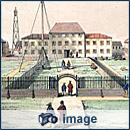

| | In the early spring of 1755 Hudson's Bay Company (HBC) employee Anthony Henday spent almost two months on the North Saskatchewan in the vicinity of modern Edmonton as part of his year-long exploration and trading expedition into the western interior of the continent. He was the first European to visit the area, although the trade in guns and other goods had begun to affect the indigenous people decades earlier. Henday's journey was an early response to the French move west and north from Lake Superior that had succeeded in intercepting much of the fur trade that had previously gone to the Bay. The comfortable and prosperous routine the HBC had established of waiting for the First Nations traders to make their annual trips to the bayside posts with canoes full of furs was about to come to an end. |
|
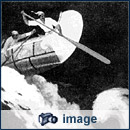
| | At the end of the 1750s the HBC got a brief reprieve when the war in North America and the conquest of Canada disrupted the trade from Montreal. The absence of competition continued into the 1760s while the British authorities in Canada struggled to minimize the European presence west of the Ottawa River, but by the end of the decade they were forced to give up the effort. By 1770 the 'pedlars from Canada,' now usually English-French partnerships, were back stronger than before and were busy setting up permanent posts along the rivers that led west. |
|



| | Within a few more years the 'pedlars' had made their way north to the Lake Athabasca-Peace River delta region, home of the best beaver habitat in North America. The Athabasca country remained the principal focus of the fur trade for the next fifty years. The direct route from either Hudson Bay or Montreal to Lake Athabasca left the North Saskatchewan far to the east of Edmonton at Cumberland House and went north across Methye Portage to the Athabasca River. There were certainly enough beaver and other furs on the North Saskatchewan in what is now Alberta, however, to attract both the Hudson's Bay Company and their opponents from Montreal, by the 1790s mostly operating under the umbrella of the North West Company (NWC). These were small scale operations at first, with traders making short trips upriver from the more established posts. Then came semi-permanent 'log tents' that allowed a few traders to spend the winter. |
|
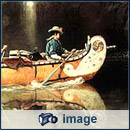
| | When the Hudson's Bay Company decided to make a serious effort to compete with the Nor'westers inland, it appointed the vigorous William Tomison in 1786 to carry out the strategy. Tomison's plan was simple and direct: keep setting up posts farther west than the competition so as to get to the furs first. This worked well enough as long as the posts were in the heart of Cree territory but west of the present Alberta-Saskatchewan border life was more unsettled and dangerous. On the upper stretches of the North Saskatchewan, the rival fur trade companies usually built their posts very close to each other, sometimes sharing a common stockade. This was partly to keep an eye on the competition but also for mutual support in case the usual efforts to stay neutral in conflicts between Cree and Blackfoot failed. The 1790s saw the construction of eight or ten pairs of HBC/NWC posts all the way west to the practical limits of canoe travel at Rocky Mountain House. |
|
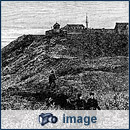
| | Several of the Hudson's Bay Company posts from 1795 onward bore the name Edmonton House and were located in the general vicinity of the modern city along with their NWC counterparts, Fort Augustus. The first Edmonton House, named for a suburb of London by some unknown HBC employee, was built alongside Fort Augustus at the mouth of the Sturgeon River near modern Fort Saskatchewan. For the first twenty-five years, it should be noted, the North West Company's Fort Augustus was very much the larger of the two establishments. The name Edmonton survived because the NWC finally in 1821 lost the great transcontinental struggle for control of the fur trade in the counting houses of Montreal and the committee rooms of the British Parliament. |
|
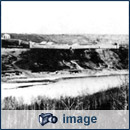
| | Under William Tomison and James Shaw of the NWC, the twin forts did a good business at their first location until 1802, becoming the centre of a network of outposts covering an area bounded by Rocky Mountain House in the west, Lac La Biche in the north and the Red Deer River to the south. A joint decision (by then James Bird and James Hughes had replaced Tomison and Shaw) to move the posts that year seems to have been in part the result of a shortage of timber for firewood. This time the companies built a single stockade to enclose both posts with a dividing wall in the centre. The place chosen was on the flood plain at the bend in the river where the power plant and water treatment plant now stand. |
|
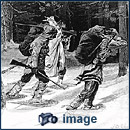
| | The decision to join forces in building their posts at a time when the companies were vigorously, often violently, competing in other parts of the North West suggests that defence was an important consideration in the move. The rapid extension of their operations westward had created a dilemma for the fur companies. Their trade depended on maintaining good relations with the First Nations but trading guns and ammunition (always a mainstay of the trade) to one group was inevitably regarded as a hostile act by their enemies. The close ties both companies enjoyed with the Cree provoked attacks by the Siksika and Atsina on Pine Island Post in 1793, on South Branch House in 1794, and Chesterfield House in 1801, in which several people were killed. |
|
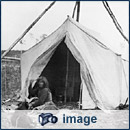
| | Combining the forts was an effective deterrent, but it did nothing to solve the problem of raiding and horse stealing between the Cree and their enemies to the south. The fur companies needed access to the nations on both sides of the river. Most of the furs came from the north but essential supplies of bison meat and pemmican could only be obtained from the south. The Peace-Athabaska delta produced vast quantities of prime quality beaver pelts but bitter experience had shown that traders could not survive the winters there without importing food. Denied access to the supplies of pemmican from the plains, the whole great northern trade network would collapse. Edmonton was rapidly evolving from fur trade post to the food collection and fur trans-shipment centre for the western region although it took some time to work out the details. |
|
|
| | One false start in the direction of solving these problems came in 1810 when the companies decided to try to separate the two components of the trade. Forts Edmonton/Augustus were moved down river about a hundred kilometres to White Earth Creek near modern Smoky Lake. The plan was to trade only for provisions with the Blackfoot at this location and move all the fur trading with the Cree still further east to Forts Carlton/ La Montee. It didn't work. The raiding and fighting continued even after the death of the Big Man, the most confrontational Siksika leader, in 1810. After three years the White Earth Creek site was abandoned and the companies moved back to the previous location where the joint post was rebuilt on the Rossdale Flats. This time the move turned out to be permanent although that was not apparent for a few more years. |
|
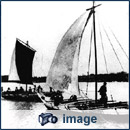
| | The advantages of the location at the bend in the Saskatchewan were not obvious but they were real. The quickest route to the new operations on the Pacific coast was well to the north of Edmonton. The most direct way to the Athabaska country was much farther east through Green Lake and Methye Portage. Edmonton offered reasonable access to the Pacific and the North along with proximity to the food supplies of the plains. There was plenty of suitable timber for boat building nearby and the North Saskatchewan could easily accommodate the York boats that were much more cost-effective than canoes. When it seemed that other places in the region might be as good, less rational considerations prevailed. It is quite clear that many of the dominant personalities in the early history of Edmonton; William Tomison, James Bird and John Rowand, for example, just liked the place and were prepared to argue in favour of keeping operations there. |
|
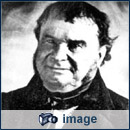
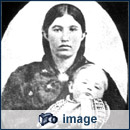
| | John Rowand first came to Edmonton in 1803 at the age of 16 as an apprentice clerk for the NWC. Around 1810 he fell from his horse and broke his leg while buffalo hunting. He was rescued by Lisette Humphraville who nursed him back to health and became his wife. By 1820 Rowand had become a partner in the NWC and when the merger of the two companies took place the following year, his talents were recognized by his appointment as a chief trader in the HBC. |
|
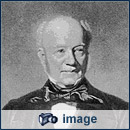
| | The elimination of competition in the fur trade meant the closing of many western posts and it seemed for a time that Edmonton might be on the list. George Simpson, the new broom in charge of merging the former rivals and making the HBC profitable once again, decided to have another try at separating the provisions trade and the fur trade by opening a post far to the south on the Bow River. Rowand was second in command of the operation which failed completely. George Simpson was not a man who took failures lightly but the Bow River experience did not shake his confidence in Rowand, who was given command of the Saskatchewan District in 1823. Simpson wanted to move the headquarters north to Fort Assiniboine but Rowand convinced him that Edmonton was a better choice. |
|
|
| | For the next half century Fort Edmonton was the most important HBC location west of Fort Garry, managing and supplying the network of posts that covered most of what is now northern Saskatchewan and Alberta but eventually expanding north up the Mackenzie River to the Arctic Ocean and west to the headwaters of the Peace. Urban centres grow by adding new functions. Furs continued to be traded at Edmonton (they still are) but by the 1830s most of the growing population of the fort worked at transporting furs out to England in the spring and yearly 'outfits' of trade goods and supplies to the posts in the fall. York boats had to be built for the river route down the Saskatchewan to Hudson Bay, requiring the services of boat builders and blacksmiths. Hundreds of horses were needed for the pack trains that carried goods for the north across the watershed to Fort Assiniboine on the Athabaska River. They had to be cared for and required feed in the form of oats and barley which were grown in fields near the fort along with root crops like potatoes and turnips for the human residents. |
|
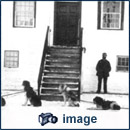
| | The combined HBC-NWC forts accommodated the expansion through the 1820s, but by the end of the decade it was getting crowded. Serious floods in 1825 and 1830 decided the matter, and in the latter year construction began on a new fort higher up the bank near where the Alberta Legislature now stands. Rowand's bigger and better Fort Edmonton, meticulously reconstructed at modern-day Fort Edmonton Park, reflected its growing importance. It had a trading and fur storage area, extensive employee living quarters, a blacksmith shop, a boat building shed, a corral for livestock and several other buildings. The dominant building, however, was Rowand's residence, the three-storey 'Big House.' Impressive even today, in the 1830s it was the largest structure between Red River and the Pacific. |
|
|
| | Although called a fort and enclosed by a substantial log palisade with bastions at the corners, Fort Edmonton was not a military structure. Military forts are intended to control territory by offering a refuge against attack until a rescuing force can arrive. For the many HBC forts across western Canada there was never a possibility that a rescuing force would be available. They were intended to be self-sufficient islands that could survive in the midst of much larger and often warlike first nations by means of trade and diplomacy. The stockades protected against casual theft and violence but, as the British army officer Lt. Vavasour who visited Edmonton in 1845 during the war scare with the Americans known as the Oregon crisis reported, the fort would have been entirely unable to withstand a determined attack. Fortunately it never had to. |
|
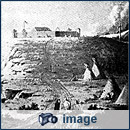
| | Because Edmonton was the administrative centre and transportation hub for the northwestern interior of the continent, all travellers in the region passed through and often stayed at the fort. These included aristocratic adventurers like the Earl of Southesk and Lord Milton but the most famous was certainly the painter Paul Kane who spent several months in and around Edmonton in 1846-7. In addition to his paintings, his vivid descriptions of life in the fort, give us the clearest idea of what it was like to live in Edmonton in the heyday of the fur trade. |
|
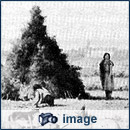
| | In the 1840s others who were not employees of the HBC began to arrive in Edmonton with the intention of staying. The first of these was the Methodist missionary Robert Rundle in 1840, followed two years later by the Oblate Father Jean-Baptiste Thibault. John Rowand was dubious about the possible impact of missionary teachings on the fur trade but the HBC was under pressure in Britain to advance the cause of Christianity so he made room for them. |
|
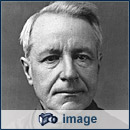

| | Rowand died in 1854 well before any real threats to the dominance of the fur trade materialized. His successors, William Sinclair and W.J. Christie, faced more varied and imminent ones. The HBC monopoly of the fur trade was under attack by free traders in Red River, by Americans from the south and, most seriously, in the British Parliament. As part of the process of deciding whether or not to renew the HBC monopoly, the British government sent a scientific expedition under Captain John Palliser in 1857 to assess the agricultural potential of the prairies. Palliser and his scientists were very favourably impressed by the Edmonton area and their report was bound to attract the attention of outsiders. A few gold miners began working the gravel of the North Saskatchewan about the same time and in 1862 a party of 175, calling themselves the Overlanders, passed through on the way to Cariboo gold rush in British Columbia. Under the dynamic leadership of Father Lacombe the Oblate fathers expanded their operations in the Edmonton area in the 1860s from their base at St. Albert. One of their number, Father Scollen, started the first school in Edmonton in 1862. |
|
|
| | Edmonton's development had always been tied to events and decisions far away. In the mid-1860s negotiations in London and Ottawa were under way that would determine the future of the settlement. The railway was revolutionizing transportation everywhere. Some people were bold enough to believe that a line could be built right across the continent and make possible the union of all British territory from Vancouver Island to Newfoundland. |
|

| | The first step was the Confederation of Ontario, Quebec, New Brunswick and Nova Scotia in 1867. The Prime Minister of the new Canada, John A. Macdonald, had carefully built into its constitution provision for expansion to the west. Talks had been going on for some years about the possibility of Canada buying out the HBC control of Rupert's Land. Now the bargaining became serious. With pressure applied by the British government, agreement was reached in 1869. Nobody who lived in Edmonton or anywhere else in the HBC lands was consulted about the transfer which resulted in a resistance movement led by Louis Riel at Red River in the fall of 1869. |
|
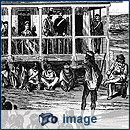
| | By May of 1870 the Canadian government had met Riel's demands and all the territory west to British Columbia, including Edmonton, became part of Canada. |
|
|
| | The only thing that was certain for the hundred and fifty or so people who lived in and around Fort Edmonton in 1870 was that change would be coming. Links to the outside world had already started to diversify with the development of the overland route from Red River known as the Carleton Trail. Steamboats might soon appear on the river. But the great question was where the railway line would go. Surveyors and explorers were at work looking for passes through the mountains. Most people assumed that the railway would have to run through the North Saskatchewan valley, the part of the North West Territories identified by the Palliser expedition as most suitable for agriculture. Edmonton was pencilled in on most of the seriously proposed routes for the great railway. The future looked promising for Edmonton in 1870 but two decades of uncertainty would follow. |
Chapter 3. Years of Optimism and Uncertainty, 1869-1891 |
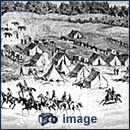
| | The changes that everyone expected as a result of Edmonton becoming part of Canada were barely perceptible for the first decade, a situation that the settlement shared with the rest of the Prairies. John A. Macdonald's pacific railway scheme collapsed in 1873 in a welter of scandal and corruption. Without the railway, commercial agriculture was impossible in the region. Such growth as the little community experienced in the 1870s was due to improvements in the fur trade transportation system into the north and the first signs of federal government activity in the form of surveyors measuring out potential farm land into townships, ranges, and sections, the North West Mounted Police and Indian agencies. By the end of the 1870s, in fact, the Métis settlement at St. Albert boasted a larger population. |
|

| | Through the 1870s the growth of a coherent community outside the fort was hampered by the presence of the Hudson's Bay reserve lands, a rectangular block that took in the area between the modern 101st and 121st Streets and from the river north to where the CNR yards are today. The fort, still the centre of most economic activity, was effectively separated from the growing accumulation of non-HBC businesses farther down the river bank by several kilometres of bush. The HBC was willing to subdivide and sell its lands but only at the high prices generated by a major land rush. Since that did not materialize, the HBC reserve remained unoccupied for decades. The rest of the area on both sides of the river was not surveyed until the early 1880s which meant that those who wanted land for farming or commercial purposes were squatters without legal title to their river lots. |
|

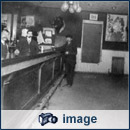
| | In spite of the fact that Edmonton grew by barely more than a hundred residents in the decade, the 1870s saw important developments almost every year. The North West Mounted Police arrived in the fall of 1874 and though they soon moved their divisional headquarters down river to Fort Saskatchewan, a detachment remained in the town. The steamer Northcote began service on the river in 1875 and Donald Ross opened the first hotel the following year. In 1878 William Bird opened a flour mill at Mill Creek on the south side of the river, giving local agriculture a much-needed boost. |
|
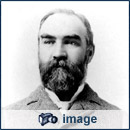
| | In 1877 the telegraph reached Hay Lakes, thirty kilometres south. Two years later it was extended to Edmonton, providing a direct and immediate link to the outside world. The telegraph operator, Alex Taylor, started distributing a weekly news summary obtained from Winnipeg and in 1880 joined forces with Frank Oliver, a merchant who had imported a small hand press. The result was Edmonton's (and Alberta's) first newspaper, the Edmonton Bulletin. |
|
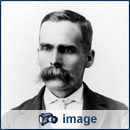
| | It is hard to overestimate the impact of Frank Oliver on Edmonton over the next thirty years. He was one of a small group of independent merchants who came to Edmonton in the late 1870s. Men like Donald Ross, Malcolm Groat, John A. McDougall and Matt McCauley all played large roles in developing the economy of the city and creating its earliest institutions. Oliver, however, because of his journalistic and political skills was the most influential by far. Oliver was born near Brampton, Canada West, and worked for a local newspaper and then for the Toronto Globe before moving to Winnipeg in his early twenties. Here he worked for three years as a printer for the Manitoba Free Press before making his way to Edmonton in 1876. Oliver's two life-long passions were a very independent variety of Liberalism and Edmonton. He used his newspaper tirelessly to promote both until the 1920s and represented his community in the NWT legislature and the House of Commons for thirty-five years, except for a brief period in the late 1880s. |
|
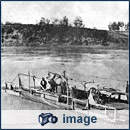
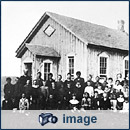
| | When the first issue of the Edmonton Bulletin appeared on 6 December, 1880, the future looked promising. John A. Macdonald and the Conservatives had returned to power in Ottawa with a renewed determination to push the Pacific railway forward and everyone continued to assume that it would follow the route already surveyed through Edmonton and the Yellowhead Pass. John Walter started his ferry service across the river in 1881 while the same year the first small coal mining operation began to exploit the seams that had long been noted on the riverbank. In October the HBC, noting the high prices for land in Winnipeg, subdivided the portion of its reserve closest to the river and put the lots on sale. Hundreds of lots were snapped up by speculators before the end of the year and hundreds more at a second sale in spring of 1882. The 1881 census reported a population for Edmonton of 263, up 115 from the last count in 1878. At last, the community, whose numbers had remained stagnant for a decade, was starting to grow rapidly. |
|
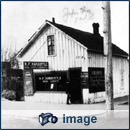
| | One sure, if not particularly desirable, sign of the burgeoning economy of Edmonton was conflict over land. Those who could not afford to get in on the speculative frenzy of the HBC land sale began casting their eyes on the squatters' river lots. In February of 1882 there were two episodes in which individuals tried to take over previously claimed lots by putting up buildings on them. In each case a vigilante group quickly assembled and destroyed the offending structures. Guns were drawn and bloodshed narrowly averted. Completion of the survey and the collapse of the real estate market in the summer cooled things off. |
|
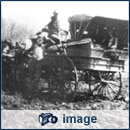
| | As early as the summer of 1881 there were disturbing rumours that the new Canadian Pacific Railway company was planning to move the main line of the railway far to the south. Edmontonians dismissed the idea as ridiculous and clung to the hope that it was not true until Parliament made it official by amending the CPR charter in the spring of 1882. The mood of optimism vanished and some recent arrivals left. Those who remained talked bravely of the natural advantages of the area and touted schemes for new and better railways east to Hudson Bay and north to the Peace River country. The bitter reality was that Edmonton had been left high and dry. Another decade would pass before so much as a branch line appeared and double that before a rival to the hated CPR reached the north side of the river. To the south things were changing as the end of steel moved rapidly west from Winnipeg.. In the summer of 1883, construction of the line neared the Rockies and an obscure NWMP post called Calgary suddenly became the most rapidly growing town in Alberta. Edmontonians who wanted to get to the outside world could now get on Donald McLeod's stagecoach and travel south to Calgary and the railway in a mere five days. Instead of five gruelling weeks overland to Winnipeg, it could now be reached in less than one, with the immediate prospect that, from there, any major city in North America was only a few more days away. |
|
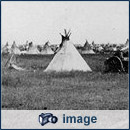
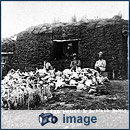
| | The building of the railway coincided with (although it did not cause) the sudden disappearance of the great bison herds that had sustained the Cree and Blackfoot and other First Nations on the prairies from time immemorial as well as the fur traders throughout the north in recent times. The fur companies could easily substitute other kinds of preserved food brought in on the railway but for the native population it was a different matter. By the mid 1880s many bands were near starvation, and were eating gophers in an effort to stay alive. Farther east along the valley of the North Saskatchewan, settlers in and around Battleford and Prince Albert, like those in Edmonton, had lost their expected railway connection. The large Métis community around St. Laurent and Batoche had somehow been missed by the special surveys like the one that confirmed the river lot boundaries in Edmonton in 1882. All these discontents came to a head in 1884 when Louis Riel accepted an invitation to return from his exile in the United States and try to get the attention of Ottawa. |
|
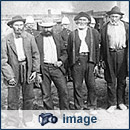
| | A tragedy of errors on all sides now ensued. John A. Macdonald mistrusted Riel's motives and failed to take Western grievances seriously. Riel overestimated the support he had from the settlers, the First Nations and even among the other Métis communities at places like St. Albert. He seriously underestimated the power of the Canadian government which had multiplied since the Red River standoff of 1869-70. The result was the bitter little civil war known as the North West Rebellion that broke out in March of 1885 when Riel and his followers proclaimed a provisional government and tried to expel the Canadian authorities from the valley of the North Saskatchewan. The fighting was all several hundred kilometres away from Edmonton, but the events had a considerable impact nevertheless. |
|
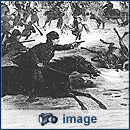
| | Word of the first shots fired and men killed at Duck Lake on March 26 reached Edmonton by telegraph the following day. Then the line went dead. Whether this was a deliberate act on the part of rebel sympathizers or one of the innumerable natural interruptions in service is hard to say. The citizens of Edmonton had no doubts and panic gripped the community for a couple of weeks. A volunteer company of thirty or so quickly materialized and collected the available weapons at the HBC fort. The fort's three little ceremonial brass cannons were dusted off and parties were organized to cut trees and clear fields of fire. Occasional travellers from the south brought word of further engagements between the rebels and Canadian troops, none of which sounded like victories for the government side. After ten days of tension it was decided to send a messenger to Calgary to find out when the relief column reported to be assembling under the command of General Thomas Bland Strange might be expected. J. Mowat made the trip in the amazing time of thirty-six hours, and on 22 April, another despatch rider brought word that the soldiers had left Calgary on the 20th. Rumours of massacres and impending attacks continued until 1 May when NWMP Superintendent Sam Steele led his advance guard of the Alberta Field Force into Edmonton. |
|
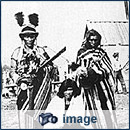
| | The citizens of Edmonton were not pleased to discover that General Strange planned to move down river as soon as possible in pursuit of Big Bear, whose Cree band had killed several people at Frog Lake. Strange had disbanded the Edmonton Home Guard when most of them decided to join Steele's Scouts. Only a company of the 65th Mount Royal Rifles was to be left behind. When the commanding officer of the 65th, Lieutenant Colonel J. Aldéric Ouimet organized and armed a Métis volunteer unit at St. Albert, a delegation led by John A. McDougall demanded that their Home Guard be reinstated. This was done. Government rifles and ammunition were not available but were promised as soon as the next shipment arrived. By the time it did, the Métis forces had been defeated at Batoche, and the rebellion was effectively over. The soldiers stayed for a few more weeks and then left for home, leaving Edmonton in its pre-rebellion doldrums. The fears of the residents during the uprising were not entirely without foundation. Edmonton had few local resources and was far from outside help had the rebellion spread westward. The fact was, however, that the generally good relations between the settlers and the Métis and First Nations communities in the area were a better defence than forts and guns. |
|
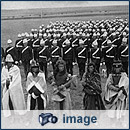
| | The mood in Edmonton in the aftermath of the loss of the CPR and the rebellion was reflected in the election for the North West Territories Council in September of 1885. Frank Oliver, running for re-election, suffered an electoral defeat for the only time in his political career. His opponent was a comparatively colourless physician with vaguely Conservative connections, Dr. H.C. Wilson, who squeaked out a narrow victory in the voting. One of the reasons for Oliver's defeat was his outspoken support for the continuation of the unpopular prohibition law in the Territories. But the other, and perhaps deciding factor for the voters, was the feeling that in times of economic uncertainty it would be prudent to choose a representative who would work more easily with the Conservative-dominated NWT Council and the Conservative Lieutenant Governor, Edgar Dewdney, whom Oliver very publicly detested. |
|
|
| | The political change made little difference to the economic and population growth of the straggling village on the Saskatchewan. The country and most of the western world were in the grip of a prolonged economic recession and even the lands close to the CPR were not attracting large numbers of settlers. By 1888 the NWT Council had been changed to the Legislative Assembly and the Edmonton district was entitled to two members. In the election of that year both Wilson and Oliver were elected. In 1889 the local economic picture had improved to the point that Oliver, John A. McDougall and Matt McCauley founded the Edmonton Board of Trade. A subsidiary of the CPR, the Calgary and Edmonton Railway Company, started work on a line between the two places in 1890. |
Chapter 4. Railways, Business, and Politics, 1891-1913 |
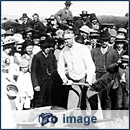
| | The arrival of the Calgary and Edmonton Railway on the south side of the river in the summer of 1891 was the most important turning point in the history of the community since John Rowand had persuaded his HBC superiors to keep their western headquarters there seventy years before. On the one hand, the presence of the railway meant that Edmonton would not remain an isolated village. On the other hand, the fact that the rails ended on the south side of the North Saskatchewan River confronted Edmontonians with a crucial choice; they could take the temptingly easier option of moving across the river, or they could stay put. Moving over could have made Edmonton an economic satellite of Calgary and it would probably have developed into a regional service centre like Red Deer. Staying on the north side, asserting the community's independence from Calgary and the CPR and re-asserting historic ties with the north provided at least the opportunity to create a major city. |
|
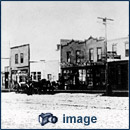
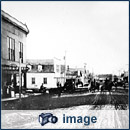
| | That would happen eventually, but there were many obstacles along the way. The first was the rapid development of the town of South Edmonton (later Strathcona). The directors of the Calgary and Edmonton Railway quickly demonstrated that the lessons of the building of the CPR main line had not been lost on them. The surest way to make money in the railway business was by determining the location of town sites and developing the surrounding lands. Control of a thousand acre parcel of land on the south side together with the very considerable engineering difficulties and expense involved in building a bridge across the river provided a double disincentive for not extending the line to Edmonton. Since railway company would not build the bridge, Edmontonians would have to do it themselves or with help from Ottawa. In the meantime, South Edmonton grew quickly. Within a few years it was almost as big as Edmonton and had its own newspaper, the Alberta Plaindealer, by 1894. |
|
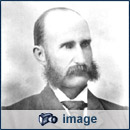
| | The leading citizens of Edmonton reacted to their changed circumstances by moving to incorporate the settlement as a town. Matthew McCauley was elected as the first mayor in February of 1892. He did not have long to wait for his first political crisis. On June 18 someone noticed that the federal government land agent, Tom Anderson, was loading files and papers into a wagon. 'Timber Tom' was on old foe of Frank Oliver who had already identified him as part of the syndicate of property owners who owned the South Edmonton townsite. An angry crowd quickly gathered and disabled the wagon while the mayor, Oliver and others sent lengthy telegrams off to Ottawa demanding that the planned move be cancelled. Mayor McCauley called out the Home Guard and distributed rifles left over from the rebellion. The tiny Mounted Police detachment in town was powerless to intervene and prudently decided to try to defuse the situation by promising to mount a guard on the wagon until word arrived from Ottawa. When Superintendent Griesbach brought twenty reinforcements from Fort Saskatchewan, he supported the decision not to intervene. Ottawa quickly backed down by agreeing that the main office would remain in Edmonton with only a branch office south of the river. |
|
|
| | Mayor and council had more mundane but ultimately more important issues to consider. Streets had to be laid out and some provision made for essential services. Fire protection was provided by a volunteer organization using water tanks buried at intervals. An electric power company had been operating since 1891 and the town encouraged the creation of a telephone company in 1893. A few brick buildings were starting to appear among the frame structures on both sides of the river, including a new two-storey Hudson's Bay Company store. By the 1890s, Edmonton had a thriving Roman Catholic church/school/seminary complex at St. Joachim's, soon to be joined by the first hospital in the town staffed by the Grey Nuns. The three major protestant denominations, Methodists, Anglicans and Presbyterians, were all well-established and growing. An amazing variety of sporting activities helped fill the leisure hours of the citizens. By the time the town was incorporated it boasted clubs for cricket, lacrosse, baseball, soccer, tennis, and athletics in the summer; hockey, curling and skating in the winter. Within a few years a bicycling club and a golf club had been added and the curling club had built an indoor rink. South Edmonton provided a convenient and made-to-order rivalry in hockey and several other sports. |
|
|
| | The federal election of 1896 brought an end to the long rule of the Conservative Party and hope to Edmonton that the new Liberal government of Wilfrid Laurier might be more amenable to paying for a bridge across the Saskatchewan, especially since Frank Oliver had won the single Alberta seat for the Liberals. The bridge was duly promised in 1897 after the town agreed to put up $25,000 as its share, but it would take several years to work out the details. In the meantime, Edmonton was distracted from its railway preoccupations by two years of excitement created by the Klondike gold rush. It was possible to get from Edmonton to the gold fields of the Yukon, although no one with any experience of travelling in the North West in the 1890s would have chosen to do so. Edmonton's merchants, assuming correctly that a sizable percentage of gold-seekers would be rash enough to try it anyway, set about encouraging them. Maps and pamphlets showing highly theoretical routes to the Yukon were rushed into print. All manner of supplies were sold to the 1500 or so gullible adventurers who set out from Edmonton in 1897 and 1898. A few actually made it after as long as eleven months arduous travel, although none apparently in time to get in on the rush. |
|


| | The false dawn of the Klondike rush was fading just as the real building blocks of Edmonton's explosive growth from town to city were falling into place. All the conditions that had held back the settlement of the Prairies were changing at once. Early-ripening Marquis wheat was now available. Free homestead land was running out in the United States. The long economic depression of the late nineteenth century was ending, and grain prices would rise for the next two decades. The aggressive recruiting policies of the new Minister of the Interior, Clifford Sifton, were having their effect, bringing thousands and then tens of thousands of immigrants where hundreds had come before. Suddenly the building of a bridge across the Saskatchewan was almost incidental, and there was talk of a new transcontinental railway along the original route of the CPR west through Edmonton and the Yellowhead Pass. Sober economists were predicting that Western Canada would eventual have fifty million people. South Edmonton's rather reluctant decision to incorporate as a town in 1899 under the new name of Strathcona no longer seemed a serious threat to the older community on the north side of the river. |
|
|
| | Queen Victoria's golden jubilee on the throne on May 24, 1897 marked the peak of enthusiasm for the British Empire in Edmonton as elsewhere. Two days of celebrations including a parade, races and other sports marked the occasion. It seemed perfectly natural two years later that young men from the town and district should compete for positions in the contingent of Canadian Mounted Rifles going off to fight in South Africa. |
|
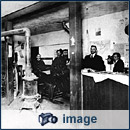
| | The reverse of this pro-imperial ardour was contempt and suspicion for newcomers who did not speak English. Local newspapers disapprovingly noted the arrival of the first groups of 'Galicians,' as Ukrainians were commonly called at the time, with disapproval. Clifford Sifton might see them as the solution to filling up the prairies but his fellow Liberal MP and owner of the Edmonton Bulletin, Frank Oliver, wanted no part of visible and/or audible minorities. The Alberta Plaindealer in Strathcona was even more outspoken. They came anyway and helped make Edmonton, along with Winnipeg, the seedbed of Canadian multiculturalism. |
|
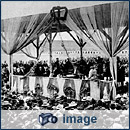
| | As the new century began, Edmonton's rapid population growth became explosive. The 1901 census counted just over 2600 people in the town. By the next census in 1911 Edmonton was a city of almost 25,000. After absorbing Strathcona the following year it reached 50,000. Much of the increase was a result of continued agricultural immigration to the surrounding area but there were new factors as well, the most important being Edmonton's designation as capital of the new Province of Alberta in 1906. This brought not only the civil service jobs created by the rapidly growing provincial administration but also the University of Alberta, which was located in Premier A.C. Rutherford's constituency of Strathcona. Provincial government sponsorship of railways like the Alberta and Great Waterways north-east to Ft. McMurray and the Edmonton, Dunvegan and British Columbia north-west to the Peace River country directly benefited the capital. |
|
|
| | Edmonton now faced the daunting task of trying to cope with the problems of a boomtown while building a solid institutional base for the future. The elected representatives of the town and, after 1904, the city, employed an interesting combination of old-fashioned civic pork barrelling and the newest techniques of municipal administration to cope with the many challenges. The results were predictably mixed and in some cases left an unfortunate legacy of debt and urban sprawl that took until the 1950s to overcome. |
|
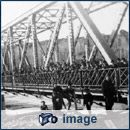
| | The long-delayed completion of the Low Level Bridge in 1902 gave Edmonton its first railway link and negotiations were already under way with the Canadian Northern for its main line to be extended through Edmonton to the west coast. Incorporation as a city in 1904 gave the mayor and city council new powers to address the problems of growth and advertised Edmonton's emerging status as a major metropolitan centre. The early 20th century was a time of experimentation and enthusiasm for novel approaches to urban problems. No city in Canada entered more wholeheartedly into the spirit of innovation than Edmonton, whose leaders seemed determined to present the city as the most progressive in North America. That meant, among other things, an administration headed by a commissioner who handled the day-to-day running of the city and reported to mayor and council. Edmonton went farther than any other Canadian city in adopting the single tax on real estate ideas of the American reformer Henry George. It also plunged boldly into the field of municipally owned utilities. The privately owned electric and telephone companies were taken over when they hesitated to invest in expansion. When a private street railway company failed to start operating on time in 1908, the city moved in. Water and sewer were city-owned from the start. |
|
|
| | From the perspective of the following century it might seem odd that a city government entirely dominated by developers and businessmen should embrace so completely what is sometimes called 'gas and water socialism.' The reasons are simple enough. Municipally-owned utilities could offer special rates to industries as an incentive to locate in Edmonton. City council regarded this as an essential tool in their ongoing competition with other western cities for economic assets. As for the single tax on real estate, most local speculators did not hold property long enough to be affected by it so that non-resident property owners shouldered much of the burden. It was argued that using the assessed value of land as the basis for taxation would encourage property owners to build on their lots or sell them to someone else who would. The decision of the HBC to sell much of its remaining land in the centre of the city in 1912 may have been partly due to the property tax system. |
|
|
| | Municipal ownership of utilities and the street railway could also be used to benefit the developers of new residential property. The temptation to annex more land, subdivide it and provide it with roads, sidewalks, electricity, telephone lines, water and sewer pipes and streetcar tracks proved irresistible. Council cheerfully voted to borrow money to extend all these services to distant fields and pastures owned by themselves, their friends and relations. By 1920 Edmonton had the lowest population density of any Canadian city and some of the highest costs for services. The amalgamation of Edmonton and Strathcona in 1912 can be seen as part of the process of expansion. |
|
|
| | Although Strathcona was incorporated as a city in 1906 and continued to promote itself as a rival to Edmonton, its drive for independence was half-hearted at best. Strathcona's elected representatives were not prepared to take the risks of their Edmonton counterparts, and fell steadily behind. By the time Edmonton was confirmed as provincial capital in 1906, the issue was largely decided. The population figures told the story. In 1901 Strathcona's population was 60% of Edmonton's; by 1906 it was only 26%. After losing out to Edmonton for both the new railway main lines, Strathcona threw its support behind the movement to persuade the CPR to build a high level bridge across the valley. Strathcona hoped that the bridge would tie it directly into future branch line construction to the north. Edmontonians more realistically supported the bridge because it would add an important link to the growing network of ties between the two communities. Edmonton's telephone company already supplied services to Strathcona and when the Street Railway company was organized in 1908 it immediately absorbed the Strathcona Radial Tramway Company. |
|
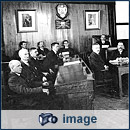
| | Not coincidentally 1908 was also the year in which Edmonton first broached the idea of amalgamation. The idea was received coolly south of the river at first, but the idea made sense to many people. A petition calling for amalgamation was circulated in Strathcona in 1909 and in the municipal election campaign of 1910 a political group emerged committed to carrying the plan forward if elected. The pro-amalgamation group won all seats in the election and began negotiations at once. Agreement was quickly reached and a vote on the plan in September, 1911 resulted in an overwhelming majority in favour. Provincial legislation formalized the merger early in 1912. |
|
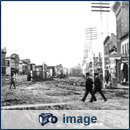
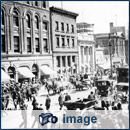
| | Photographs of Jasper Avenue taken in 1903 and ten years later present a startling contrast. In the earlier ones, Edmonton is a small frontier town with a few horses on the dirt roads and a scattering of pedestrians on the wooden sidewalks. There are a few brick buildings but the town's main street is dominated by two storey frame structures. By 1913 the transformation is complete, and a bustling modern city is in place. The frame buildings have disappeared; Jasper Avenue is paved with streetcars running down its centre; and the concrete sidewalks are crowded enough that the busy citizenry spill over into the street in places. Where in 1903 there was one bridge across the river there are now four. Many of the new buildings on Jasper Avenue housed real estate offices and new residential subdivisions were being created almost daily. An interurban streetcar line to St. Albert was under construction. |
|
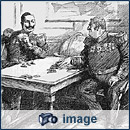
| | Unfortunately for Edmontonians the prosperity of the new city that had sprung into existence was dependent on a continuous flow of immigrants to take up land in the surrounding countryside and on a willingness on the part of investors, mainly European, to lend the money needed to finance the city's growth. In the summer of 1913, because of wars in the Balkans and fears of a much greater conflict, both began to drop. The sudden financial drought affected all western Canadian cities but Edmonton most of all because its growth spurt was the most recent and because the city had borrowed more heavily than others. The sinking fund to provide for the redemption of city bonds had, against the advice of accountants, invested heavily in mortgages. Essentially everything depended on a continuation of the upward spiral in real estate values: the tax base, the sinking fund and the extension of services to areas far from the city centre. When credit suddenly dried up in the summer of 1913, Edmonton entered a prolonged period of financial crisis that would not finally resolve itself until the 1950s. |
Chapter 5. War and Depression, 1913-1939 |
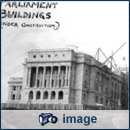
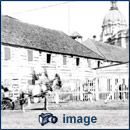
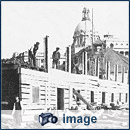
| | Edmonton entered the year 1914 with the general feeling of confidence that had marked the last two decades considerably shaken. 1913 had been a year of striking contrasts with the opening of the new legislature and the high level bridge balanced against the sudden credit freeze that had brought construction almost to a halt and produced the first serious unemployment the city had known. In December a thousand unemployed men marched on city hall. There had also been an ominous drop in the city's tax receipts. Most citizens regarded these portents as only a temporary setback and approved their city council's plans to go ahead with bringing natural gas to the city from the newly discovered field at Viking. They also thought it made sense to prepare for future growth by changing to the present street numbering system from the street names that had been used to that time. The only named streets that survived were Jasper and Whyte avenues and a handful of lesser thoroughfares. |
|

| | Had the world remained at peace in 1914, those who thought the economic downturn was a minor hitch might well have been right, but events in distant Europe were about to take a hand. The assassination of the heir to the Austrian throne by a terrorist group in the city of Sarajevo in June produced a diplomatic crisis that refused to go away like the others that had threatened the peace over the previous few years. In May of 1914 the Edmonton Bulletin had expressed a global consensus when it opined that modern weapons had made a general war impossible but suddenly in August the troops were marching and the major European powers, including Britain, found themselves at war. That meant that Canada, still legally a British colony, was also at war. With French, German and Russian armies numbering in the millions, Britain could only hope to survive as a major power by relying on manpower from the Empire. Most Canadians responded enthusiastically to the call and Edmontonians were no exception, although there was little enough to work with at first. |
|
|
| | Canada in the period before the First World War spent less money per capita on defence than any other country in the world and relatively little even of that insignificant amount made its way to the new provinces of the West. Although a number of residents of the city had served with distinction in the South African War, requests to organize militia units in Edmonton were ignored until 1908. In that year a mounted regiment, the 19th Alberta Mounted Rifles (after 1911, the 19th Alberta Dragoons), and an infantry unit, the 101st (Edmonton Fusiliers), were authorized, and recruiting began. The city provided land near the exhibition grounds, although the splendid Prince of Wales Armouries building was not completed until the war was well under way. Militiamen got uniforms, rifles, ammunition and a week or two of training each summer at Sarcee Camp near Calgary. That was hardly enough to prepare them for the machine guns, massed artillery, and poison gas of the trench warfare to come, but even the professional soldiers of Germany and France had not anticipated war fought with the technology and industrial production of the 20th century. |
|
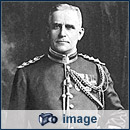
| | Canada's erratic Minister of Militia and Defence, Sam Hughes, managed to make a confused situation worse by scrapping all the existing militia units with local ties in favour of new and theoretically interchangeable numbered battalions. Both Edmonton units suffered this fate; a squadron of 200 from the Dragoons left in August and the Fusiliers, 1200 strong in early September. The Fusiliers were disbanded on reaching Valcartier and most of the men incorporated into a new 9th Battalion. That unit reached England where it too was broken up as replacements for other battalions. The last privately-financed regiment in the Canadian Army also had its origins partly in Edmonton at this time. Hamilton Gault, a wealthy Montreal businessman paid for the raising and equipping of Princess Patricia's Canadian Light Infantry and almost a quarter of the original members of the regiment came from Edmonton, including their pipe band. |
|
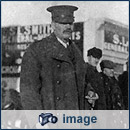
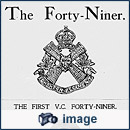
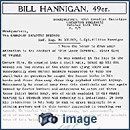
| | Before the year 1914 came to an end, two more battalions were allowed to begin recruiting in Edmonton, the 49th and the 51st. One of the Dragoons officers, Major W.A. Griesbach, was brought back from England to command the 49th. 'Billy' Griesbach was one of the most colourful individuals in the early history of Edmonton. He had come to the area as an infant when his father took over command of the North West Mounted police at Fort Saskatchewan in the 1880s. He served with distinction in the Boer War and returned to Edmonton to practice law and politics. He was elected to city council and a term as mayor while still in his twenties. A Conservative in Liberal Edmonton, Griesbach was never successful in winning election at the provincial or federal level but his good humour and obvious devotion to the community made him a popular figure. When recruiting for the 49th started in January of 1915, he had no difficulty in filling the ranks in a matter of weeks. Although several more battalions were raised in Edmonton, the 49th alone kept its identity and served as a front line unit in the Third Division through all the great battles on the Western Front, from the spring of 1915 until the end of the war. |
|
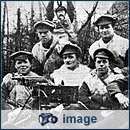
| | The 49th quickly acquired a reputation as one of the best battalions in the Canadian Army, although the cost was heavy. Just over 4000 men served in the 49th in the three and a half years the battalion fought in the trenches. Nine hundred and seventy-seven of those died and 2282 were wounded, a casualty rate of 81%. Privates John Chipman Kerr and Cecil John Kinross earned the Victoria Cross with the 49th.. The 49th thought of themselves as 'Billy's Boys' even after Griesbach was promoted and went on to command a brigade. |
|
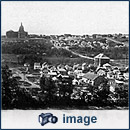
| | Although the battalion inevitably absorbed many replacements from other parts of the country, it retained a strong core of officers and men from the city and surrounding area. Private Frank R. Hasse from Lac Ste. Anne who served with the 49th from its inception to the end of the war put it best when he wrote in his diary on discovering after the Armistice that the battalion was not to be part of the occupying force in Germany, "Winding up the watch on the Rhine ... makes an appeal to some, but to the majority of Forty-Niners the only worthwhile road is that which leads to Jasper Avenue." The demands of the army quickly soaked up the large group of unemployed that had accumulated in Edmonton after the financial crash of 1913. The price of wheat went steadily higher throughout the war years and agriculture boomed. The prosperity of the surrounding country helped Edmonton's economy avoid complete disaster but it was not nearly enough to sustain growth. The city's population dropped by almost 18,000 people between 1914 and 1916, an amazing 24%. |
|
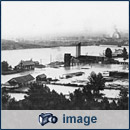
| | City employees got less than their full pay in 1914; contracts for sewer construction were unilaterally cancelled and the power plant was leased to a private company in 1916. The city took over thousands of lots for non-payment of taxes, but since there were no buyers, many of the planned subdivisions reverted to cow pastures. The city police force dropped from 134 to 58. Edmonton was even forced to introduce a civic income tax in the years 1918-1920. Oddly enough, these dire economic circumstances were the indirect but indispensable cause of one of Edmonton's finest attractions, its river valley park system. Until 1915 the valley lands were the site not only of a good deal of residential development but of industry as well. Lumber mills and brick yards lined the banks on both sides of the river. The great flood of 1915 submerged them all, and when the waters receded there was no incentive to rebuild. Credit was unavailable, and the population did not recover to 1914 levels until the late 1920s. Almost all the land in the valley reverted to the city for non-payment of taxes. |
|

| | When industry eventually revived, it made more sense to locate close to the main railway lines. In the 1950s and 1960s Edmonton did not have to go through an expensive process of acquiring and redeveloping industrial land for its unique park corridor. At the end of the war in 1918 a wave of radicalism swept North America, in reaction to the expectations raised by the idealistic side of the struggle to 'make the world safe for democracy,' and the reality of rampant inflation and falling standards of living at home. In Canada the Winnipeg General Strike of 1919 was the most dramatic example. Edmonton had its own milder version of the general strike which passed more quickly and without the bloodshed of Winnipeg's. In part this was due to the fact that Edmonton lacked the heavy industrial base to get in on war production contracts and therefore had a less concentrated working class than other Canadian cities. It was also in part the result of better working conditions in important local factories like the Great West Garment company. Edmontonians expressed their radicalism in this period mainly by voting in Joe Clarke as mayor in 1919 and 1920. |
|
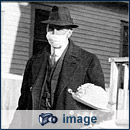
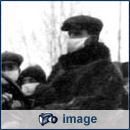
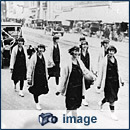
| | Clarke had first emerged as a spokesman for the working class, ethnic east end of the city as an alderman before the war and he was to remain a fixture in Edmonton civic politics for three decades.With the passing of the great influenza epidemic that killed 445 people in the city in late 1918, the return of the soldiers, and the general strike, Edmonton moved into a placid decade of slow growth. The 1920s may have roared elsewhere but in Edmonton they barely whispered. The city finally got its natural gas connection in 1923, and citizens celebrated the triumphs of the famous Edmonton Grads women's basketball team that was unquestionably the best in the world at the time, but there was not much else to cheer about. The staid and cautious United Farmers of Alberta government dominated the legislature during the 1920s, never living up to its rhetoric of agrarian radicalism. No new public buildings of note were constructed in the decade and very few houses. Some wartime aviators like Wop May and Punch Dickins tried to make a living using airplanes to supplement Edmonton's traditional water routes into the north. |
|
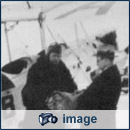
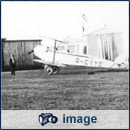
| | The technology of the war surplus planes they flew was not adequate to the challenge, however, and there was not yet sufficient mining activity in the north to stimulate the development of aircraft that could do the job. Near the end of the 1920s the aviation picture began to look more promising. City council came up with $400.00 in 1926 to make some improvements to the cow pasture called the Hagmann estate which fliers had been using for some time. They were rewarded by Ottawa designating it a 'Public Air Harbour,' the first municipal airport in Canada. The Edmonton and Northern Alberta Aero Club quickly followed and, in 1929, the heroic and highly publicized flight in an open-cockpit aircraft in minus 30s temperatures by Wop May and Vic Horner to deliver diphtheria antitoxin to Fort Vermilion, raised public consciousness about the possibilities of aviation. New larger aircraft with reliable engines and enclosed cabins like the Lockheed Vega that May and Horner's Commercial Airways bought in 1929 were becoming available. Government airmail contracts promised a steady source of revenue for those lucky enough to get them. |
|
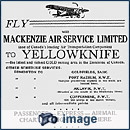
| | The 1930s was the decade in which the airplane came into its own in Edmonton. With gold and later uranium discoveries in the north, demand for a quick and reliable way to get prospectors and their supplies in grew rapidly. As the mines developed the traffic became steadier and the successful companies like Mackenzie Air Services, Western Canada Airways and Yukon Southern Transport acquired ever larger planes, capable of hauling machinery weighing several tons. By the end of the 1930s more freight was being carried by plane in Canada than in all the rest of the world, a majority of it through Edmonton into the north. It is not too much of an exaggeration to say that the air freight business was first developed in Edmonton. Important elements of aviation infrastructure like the seaplane base at Cooking Lake and the overhaul facilities of Aircraft Repair Limited were already in place. |
|
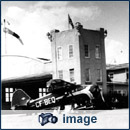
| | In 1937 the federal government provided money for extending and improving the runways at Blatchford Field. It also began operating radio and weather stations along the route that led through the Peace River country and northern British Columbia into the Yukon. These developments encouraged Grant McConachie to establish Yukon Southern Transport and begin a scheduled service to Whitehorse. This additional northern air route would soon, under the stimulus of war, expand beyond the wildest dreams of those flying it in the late 1930s. |
|
|
| | If the expansive 1920s failed to raise Edmonton's economy as much as other Canadian cities, the converse was true for the 1930s. As the country, and western Canada in particular, sank into the great depression, Edmonton did not fare as badly as most places. The population of the city continued to grow at a steady, although slightly reduced rate in the 1930s, reaching a population of 90,000 by 1939. The growth of northern aviation was one contributor to the economy. Fifty or sixty aircraft does not seem much of an economic factor but they required fuel and services of all sorts. Perhaps more importantly, as one of the very few growth areas of the period, they provided an important psychological boost to the city. Although the rural economy around Edmonton suffered as much as elsewhere from very low agricultural prices, the region did not suffer the devastating drought that produced dust bowl conditions farther south. In fact, many who were driven off the land on the southern prairies moved north to start again. As the provincial capital Edmonton had a substantial population of civil servants most of whom remained employed through the depression, although they took pay cuts and at times did not get paid at all. |
|
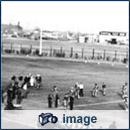

| | The Social Credit government of William Aberhart that took office in 1935 did little to help the city, although its monetary theories and very public fights with Ottawa and with the Edmonton Journal brought national and even international attention. The apparent crisis of the capitalist system had brought Joe Clarke back to the mayor's chair in 1935 and he had a few ideas about how to get things moving. In the north-east of the city, the federal government had maintained a penitentiary in the early part of the century, with the inmates put to work mining one of the coal seams in the area. That institution closed down in 1920 and a commercial mine took over until it too ceased operations in 1929. Mayor Clarke, always an enthusiastic athlete and supporter of sports activities in the city, thought that the site would be perfect for a football stadium. He set up an organization to negotiate for the site and raise the money. By the time the stadium was completed in 1938 Clarke was no longer mayor, but city council had no trouble agreeing that it should bear his name. |
|
|
| | The symbolic event that ended the decade of the 1930s for Edmonton was the royal visit of 1939. With Hitler firmly in control of Germany and building a massive war machine, it was apparent to most that war in Europe could not long be avoided. In Canada, although to a lesser degree than in the United States, many people believed that staying out of European wars was the only sensible course of action. The Canadian tour of King George VI and Queen Elizabeth was designed to solidify the support of the majority, who favoured support for Britain in the event of war. On a brilliantly sunny day in early June, the royal couple drove down Portage Avenue (soon to be renamed Kingsway in honour of the occasion). Stands on both sides of the street were filled with tens of thousands of cheering spectators, many of whom had come to Edmonton from all over the province. The long period of economic stagnation was about to end for the city, but not without the ordeal of a new world war. |
Chapter 6. War and Oil, 1940-1972 |
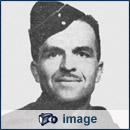
| | Barely three months after the royal visit, the war that had been expected and feared began with Hitler's invasion of Poland. The experience of the Second World War was quite different for Edmonton although a few things remained the same. Volunteers from the city and its surrounding area fought and died under the banner of the Edmonton Regiment (from 1943 the Loyal Edmonton Regiment), which had succeeded the 49th Battalion in the 1920s. Many others served in other Canadian Army units. This time around, Canada had its own navy and air force, and both new services absorbed young men, and, for the first time, young women as well. The biggest difference from a quarter century earlier was on the home front. Edmonton's population had dropped and its economy had slumped after 1914. The opposite happened after 1939, with a population increase of more than 25% by the end of the war and forced economic growth. So many flocked to the city that the federal government was forced to restrict the influx and allow only those with war-related jobs to move to Edmonton. |
|
|
| | After the First World War, the Canadian government had responded to public revulsion against the slaughter in the trenches and to financial stringency by cutting back drastically on military expenditures. Although the 49th Battalion finally got the name it should have had all along, the Edmonton Regiment, the unit operated on a shoestring and sometimes less through the 1920s and 1930s. The regiment made do with left-over equipment and training for one day a week plus a week or two in camp in the summer, although even that meagre funding dried up at times. Nevertheless the spirit was strong and the regiment was consistently rated as one of the best in the country in inspections by army headquarters. Their reward was to be assigned to the First Canadian Division (as part of the 2nd Brigade along with the PPCLI and Vancouver's Seaforth Highlanders). They were in England before the end of the year. |
|
|
| | Along with most of the Canadian Army, the Edmonton Regiment spent the next three and a half years in England training, until they were assigned to the allied force for the invasion of Sicily in 1943. Once there, they fought with great distinction in the fierce battles of the Italian campaign from Leonforte in Sicily to Ortona, the Liri Valley, and the Gothic Line. In February along with all other Canadian troops in Italy, they were shipped to Holland to take part in the final drive to defeat Germany. Although many soldiers from across the country served in the Loyal Edmonton Regiment in the course of the war, the unit retained its strong ties with the city. When the Regiment returned to Canada in October of 1945, 500 of the 800 in the unit chose to take their discharge in Edmonton. |
|
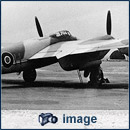
| | Other army units had less direct ties to Edmonton. One example was the South Alberta Light Horse, an armoured battalion formed in Edmonton in 1940 of companies from five Alberta militia regiments including Edmonton's 19th Alberta Dragoons and the Edmonton Fusiliers. About 15,000 enlisted in the Royal Canadian Air Force in Edmonton, and the city adopted RCAF 418 Squadron as the City of Edmonton Squadron. The navy recruited and trained approximately 3,700 recruits at HMCS Nonsuch, and at least one Edmontonian, Commander Rodney Pike, rose to command a Canadian warship, the corvette HMCS Orangeville. Edmonton had the curious distinction of being the only Canadian city not to have a warship named for it. The naval bureaucracy in Ottawa claimed that since they already had a ship named HMCS Edmunston, after the community in New Brunswick, it would be too confusing to have an HMCS Edmonton. |
|
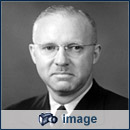
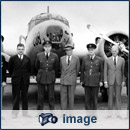
| | Mayor J.W. Fry and the city council protested this bit of official absurdity, but they had so many other pressing issues related to the war that they did not waste too much time on this one. The direct impact of the war on Edmonton came from two quite different directions. The first was the massive project to train tens of thousands of aircrew known as the British Commonwealth Air Training Plan. New bases sprang up across the country, especially in the West in 1940 and 1941, while existing airports, like Edmonton's Blatchford Field added military training operations to civil flying operations. Much of the flying training was undertaken by civilian companies under contract. In Edmonton the legendary Wilfred 'Wop' May's company Canadian Airways [Training] Ltd. ran No. 2 Air Observer's School. The Edmonton Training Flying School Ltd. operated No. 16 Elementary Flying School also based at Blatchford. Part of the Exhibition Grounds was taken over by the RCAF it became the home of No. 3 Manning Depot, where recruits were given an introduction to military life and sorted out into the various aircrew trades. The three university residences were also requisitioned and housed No. 4 Initial Training School, a facility that provided classroom instruction for aspiring pilots. |
|
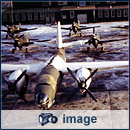
| | All these operations were up and running by mid-1941, making Blatchford Field a very busy place. When the Japanese bombed Pearl Harbor in December of that year, the American entry into the war released a much larger wave of air operations and associated activity. The Canadian and American governments had signed a military cooperation agreement creating the Permanent Joint Board on Defence more than a year before Pearl Harbor, US access to air and ground routes to Alaska were included in the agreement. The US military had been worried since the 1920s about the difficulties of defending Alaska in the event of a war with Japan. There was no land route connecting Alaska to the lower 48 states, and, in fact, the Japanese invaded and occupied the Aleutian islands of Kiska and Attu in the spring of 1942. That was as far as they got, and weather conditions alone in Alaska made the prospect of further encroachment highly unlikely. Perceptions drive action, however, and the Americans believed that supplying Alaska with war materials was vital to their national interest. That meant building a road from Alberta to Alaska and building a pipeline from the oilfield at Norman Wells on the Mackenzie to a refinery at Whitehorse. Edmonton became the headquarters for both projects. |
|


| | Thousands of American servicemen and employees of civilian contractors poured into Edmonton. The best estimate is that somewhere around 48,000 spent some time in the city and for much of the war made up about 10% of the total population. Perhaps as many as 25% of the work force found employment with the US military or the contractors. The Americans leased every bit of office space not already occupied and built more of their own. Housing was in desperately short supply, even after the crown corporation Wartime Housing Incorporated began to build several hundred houses near the airport. Many Edmontonians were uneasy about the American invasion, benign though it was in intention, but relations between the permanent and temporary residents quickly settled into a smooth relationship. When the city was hit by a major blizzard in November of 1942, the Americans pitched in immediately with all available road equipment to help clear the snow. The incident solidified a friendly relationship that was also being fed by the united war effort and the boost to the economy created by American spending had started. |
|
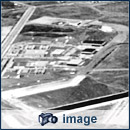
| | As the Japanese threat to Alaska waned, a new use for the air route through Edmonton emerged. Getting aircraft to the beleaguered Soviet Union was an urgent necessity and a plan to fly them from Great Falls, Montana, to Edmonton, Whitehorse, and Fairbanks (where Russian crews took over) was quickly put in place. Thousands of aircraft were flown over the North West Staging Route, which had its headquarters and control centre in Edmonton. Northern flying techniques pioneered by bush pilots in the previous decade made the route possible. The traffic was so heavy that new solutions for resulting problems had to be found. The number of aircraft movements, as many as 860 in a single day at Blatchford Field in 1943, was unprecedented, and resulted in the creation of the forerunner of the modern air traffic control system, which was adopted world wide after the war. The crowded runways at Blatchford led to the construction of a new air base at Namao, north of the city. |
|
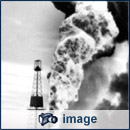
| | The frantic pace of wartime activity began to slow in 1944, and ceased altogether after the Japanese surrender in August 1945. The immediate economic prospects for the city did not seem at all promising, yet the ensuing decade, which saw the population double from 113,000 to 226,000, was one of the great growth periods in Edmonton's history. The discovery of oil at Leduc in 1947 and all the spinoffs it created was certainly a major factor but it was not the whole story. Even after the first oil refineries opened, beginning with the Imperial Oil refinery in 1948, there was little direct employment in the oil industry in the city. Drilling was in the rural areas, and the oil companies, established in Calgary for decades because of the Turner Valley field, kept their headquarters there. |
|
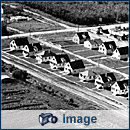
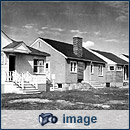
| | Edmonton's extraordinary growth in the decade following the Second World War was the product of several other factors. Agriculture, traditionally one of the mainstays of Edmonton's economy, had not been artificially inflated as it had during the First World War and was in a healthy state. The Peace River country was finally starting to realize its potential. The veterans returning from the fighting, in marked contrast to their fathers in 1919, had access to a wide variety of assistance programs designed to help them adjust to civilian life, including most prominently education and housing. The University of Alberta was bursting at the seams, and, for the first time in more than thirty years, new subdivisions were springing up to house the thousands of veterans who wanted to start families. |
|
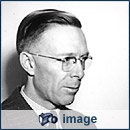
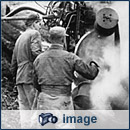
| | The period after the Second World War was also one of massive growth in government throughout the western world. Alberta, a have-not province on the edge of bankruptcy in the 1930s, and now with tens and then hundreds of millions rolling in annually from oil royalties and lease sales, was in a better position than most governments to meet the demand for new roads, schools, and other services. Although the Social Credit government of Premier Ernest Manning continued to speak the language of the Great Depression, its spending increased from $31 million a year in 1946 to $548 million annually by 1966. As the provincial capital, Edmonton was the beneficiary of much of that. In the mid-1950s, the second wave of the oil boom began with the construction of major oil and gas pipelines to distant markets and the growth of a large-scale petrochemical industry on the eastern outskirts of the city. |
|
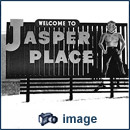
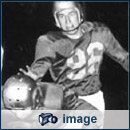
| | The 1950s was the decade in which Edmonton began to move away from its early twentieth century identity as a rather sleepy government and agricultural service centre and acquire the attributes of a major city. New multi-storey buildings were starting to change the face of downtown. In 1955 Westmount Shopping Centre, the first in Edmonton and one of the first in Canada, opened its doors, a portent of things to come. Arts organizations like the Edmonton Civic Opera and the Edmonton Symphony were thriving and with the construction of the Jubilee Auditorium had an impressive new venue. Although Edmonton joined the trend to single newspaper cities when the venerable Edmonton Bulletin ceased publication in 1951, the new medium of television made its debut a few years later. With the Edmonton Eskimos winning three consecutive Grey Cups in the mid-1950s, the decade was one of the great eras of Edmonton's sporting history. The city hired its first professional planner in 1949 to try to bring some order to its growth. Edmonton was also becoming a metropolitan area with satellite communities, planned in the case of Sherwood Park and unplanned in St. Albert, Beverly, and Jasper Place, growing up on all sides. The last two would be assimilated in the early 1960s, while St. Albert and Sherwood Park remain independent, testimonies to the failure to develop a coherent metropolitan government structure. |
|
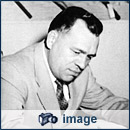
| | It was rare to see anything but white faces on the streets of Canadian cities in the 1950s and, except in Quebec, the upper reaches of business, industry, and civic politics were the preserves of those of British origin. When Edmonton elected William Hawrelak, son of Ukrainian immigrant parents who farmed near Smoky Lake, as mayor in 1951, it was the cause of newspaper comment across the country. Edmonton was, in fact, more at ease with ethnic diversity than other western cities, with the possible exception of Winnipeg. When an individual of Hawrelak's exceptional drive and ability came on the scene, he was an instant success. In spite of his business background, Hawrelak did not hesitate to aggressively promote Edmonton's array of city-owned utilities, using the profits they generated to keep down taxes and finance the expansion of city services necessitated by rapid growth. He was able to convince the council and the citizenry to build Edmonton's first real city hall in 1954 to replace the converted warehouse that had served since 1912. The design was modern and controversial as befitted the fastest growing city in Canada, but the technological innovations in the building unfortunately failed to with stand the test of time. |
|
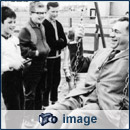
| | Mayor Hawrelak persuaded the federal government to build a new international airport south of the city to replace the crowded municipal field, a move that continues to generate controversy after half a century. He was intensely interested in building up the city's parks, and in many ways deserves to be considered the father of the river valley park system. It was Hawrelak who put several of the key components in place, most notably by converting a gravel pit south of the Mayfair Golf course into a park, now fittingly called Hawrelak Park. He was returned to office by acclamation for a second and third term, and when he ran for a fourth term, overwhelmingly defeated his opponents. Unfortunately for William Hawrelak, he been incautious in some land development dealings from the mid 1950s on. A south side motel owner named Ed Leger who felt he had been disadvantaged by one of the Mayor's transactions assembled sufficient evidence to force a judicial inquiry. The report of Mr. Justice Porter found 'gross misconduct' on Hawrelak's part, and he resigned immediately. He returned triumphantly to office in 1963 and 1964 before another land deal conflict of interest finding drove him from office. He returned a final time in 1974, and died in office the following year. In terms of putting a personal stamp on the city, William Hawrelak was undoubtedly the most important of Edmonton's mayors. |
|
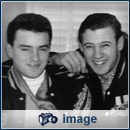
| | "As the city continued to grow through the 1960s, the baby boom generation began graduating from high schools. The demand thus created produced a spectacular boom in post-secondary education. Even though its Calgary branch campus became independent in 1964, the University of Alberta doubled in size from 5000 to 10,000 students between 1955 and 1965, and doubled again to 20,000 by the early 1970s. The university was changing from a small undergraduate institution to a major research centre. The Northern Alberta Institute of Technology experienced comparable growth. The city, now approaching 400,000 people, financed the construction of three new bridges to accommodate the traffic flows across the river.Growth and optimism were still the dominant themes in civic life, but, as the 1970s began, the pace of expansion slowed and some doubts began to be expressed about how long it could be sustained." |
|
|
| | "The big oilfields of northern and central Alberta were reaching their peak levels of production, and new ones were not being discovered that would pay to develop with oil at $3.00 a barrel. Engineers at the University of Alberta had been doing research on processes to extract oil from the Athabaska tar sands since the 1920s. Some promising results had led to the opening of the first large-scale plant, Great Canadian Oil Sands, in 1967. But extraction on a commercial scale was unproven and probably uneconomic in the 1960s. The apparent fading of the mainstay of the Alberta economy was reflected in the defeat of the provincial Social Credit government in 1971 after thirty-five years in office. Edmontonians, as they had done several times in the past when confronted by economic uncertainty, looked to the left politically and elected Dr. Ivor Dent, identified with the NDP in provincial politics, to six years in the mayor's chair beginning in 1968. The brief hiatus in the city's expansion turned out to be very temporary.Once again events in a faraway part of the world would have an impact on Edmonton, this time mainly in a positive way." |
Chapter 7. Riding the Roller Coaster, 1973-2004 |
|
| | Just as Edmonton's growth based on the expansion of the oil industry appeared to be levelling off in the early 1970s, events in the Middle East brought about far-reaching changes. The Organization of Petroleum Exporting Countries decided to restrict production by its members to drive up prices. Although many economists predicted that the cartel would be unable to persist, OPEC turned out to have come up with a highly effective strategy. Oil prices had been averaging around $3.00 a barrel for several years, and an increase in price of 25 cents was a matter of widespread comment. The price rose slowly in the first half of 1973 to $3.80 in August, then took off, reaching over $10.00 by the end of the year. By then Ottawa had frozen the domestic price at $4.00. The cartel showed no signs of collapsing and, by the end of the decade negotiations between Alberta and Ottawa had gradually brought the price up close to international levels. Then in 1979 OPEC doubled the price once again. By 1981 it reached the giddy heights of $40.00. These economic upheavals set the stage for a period of expansion that outpaced that of the 1950s, and resembled the boom times of the first decade of the twentieth century. |
|

| | Interestingly, in the pre-oil boom days of the early 1970s, some Edmontonians had turned to economic development via sport. When the World Hockey Association emerged in 1971 to challenge the NHL, Edmonton sports promoter Bill Hunter acquired a franchise and a promise that the City would build a new arena to replace the venerable Edmonton Gardens. As an economic stimulus, the new Coliseum was not much more successful than Joe Clarke's stadium had been in the 1930s, but it did put Edmonton in position to move up to the NHL in 1979. The sporting event that best symbolized the optimism of the decade, however, was the city's hosting of the Commonwealth Games in 1978. This too, brought major new construction projects with Commonwealth Stadium and the Light Rail Transit line being the major ones. More importantly, it was the first time an Alberta city had hosted a major international athletic event. The competence with which the organizers managed the preparation for the games and the enthusiasm of the thousands of volunteers impressed observers around the world, and set a new standard for the event. |
|
|
| | Expensive oil had a depressing effect on most of Canada, but the opposite was true of Edmonton, which became the fastest-growing city in the country in the 1970s. As the United States grew worried about the security of its oil supplies, there was talk of investments in the oil sands in the range of $15 to $20 billion. One massive project, Syncrude, started construction in 1974, and three other projects were in the planning stage. Conventional oil exploration in Alberta was at record levels, and oil companies were aggressively pursuing exploration in the Mackenzie delta and Beaufort Sea areas. Much of the supply business and traffic to the north came from Edmonton. The majority of the air traffic thus generated went through the city centre airport rather than the international airport south of the city. That facility had been planned and built when piston-engined aircraft equipped the world's airlines and it was assumed that trans-polar flights from Europe to the burgeoning markets of the western United States would require a fuelling stop for which Edmonton was ideally located. The arrival in the 1960s of the big commercial jets with their much longer ranges and greater reliability eliminated Edmonton as a way point. Traffic to and from the north used smaller planes that the city centre airport could accommodate, and not surprisingly most passengers preferred to avoid the extra half hour trip to the international. |
|
|
| | The combination of relatively poor economic circumstances in eastern and central Canada and boom times in Edmonton brought thousands of new residents to the city each year. The population of the metropolitan Edmonton area expanded by 160,000 people between 1971 and 1981, equal to the total population of the city just thirty years earlier. Building permits exploded from about $200 million in 1973 to over a billion dollars in 1981. High rise apartments began to line the top of the banks on both sides of the river. The provincial government started a major project to enhance the legislature grounds. New suburbs expanded in all directions, while the older bedroom communities of St. Albert and Sherwood Park were joined by new ones as towns like Leduc and Spruce Grove were drawn into the orbit of the city. |
|

| | When the second OPEC price shock hit in 1979, it seemed to solidify the future prospects of the city, even though Ottawa's National Energy Policy the following year kept Canadian prices well below world levels. But the first increase had had its effects. The high prices were a major contributor to a combination of inflation and extremely high interest rates that slowed economic activity across the industrialized world. The major oil consuming nations had made serious and effective efforts to increase efficiency and cut consumption. Higher prices had greatly stimulated exploration and production in non-OPEC countries. The result was that this time the cartel could not sustain its control of the market, and prices began to fall, dropping below $30.00 in 1982 and all the way down to $14.00 by 1986. Agriculture, which had boomed in the 1970s, nosedived as well in the 1980s with wheat prices by 1987 lower in real terms than during the Great Depression Activity in all the oil and gas sectors slowed to a crawl, and so did Edmonton's economy. Construction ground to a halt as vacancy rates for both residential and commercial space rose rapidly. Unemployment in the building trades was running at 75%. |
|
|
| | With the recession in full bloom, Alberta's unemployment figures hit double digits in 1983, and the inflow of people from other parts of the country reversed itself. Two Alberta-based banks, the Canadian Commercial Bank and the Northlands Bank, failed in 1985. Two years later the high flying Edmonton based Principal Financial Group declared bankruptcy. To add to the litany of bad news, that August a tornado ripped through the eastern part of Edmonton, destroying several businesses and, a trailer park and killing twenty-five people. As usual, Edmontonians responded to hard times by turning left in their politics. Lawrence Decore won the mayoralty from Cec Purves in 1982 when he left to lead the provincial Liberal party, an alderman with strong environmental and NDP connections, Jan Reimer, became the first woman mayor in Edmonton's history. |
|

| | In sharp contrast to the dismal economy of the 1980s, the decade was something of a golden age for sport and entertainment for the city. As the 80s began, the Edmonton Eskimos were in the middle of an unprecedented string of five straight Grey Cup victories. The city hosted its second very successful major international sporting event with the World University Games in 1983. Just as the football team's total dominance of the league began to fade somewhat (the Eskimos did win another cup in 1987), the new NHL Oilers emerged as the dominant team in professional hockey under the leadership of the incomparable Wayne Gretzky. After surprising fans and observers by going to the Stanley Cup final before losing to the New York Islanders in 1983, the Oilers went on to win the championship in four of the next five years. They added a fifth cup in 1990 after recovering from the trauma of Wayne Gretzky being traded to Los Angeles in 1988. Other Edmonton teams and individuals were also winning in the decade. The University of Alberta Golden Bears hockey team were perennial contenders for the national championship, and coach Clare Drake set a record in 1985 for wins by North American college and university coaches. Pat Ryan's team won the national curling championship in 1988 and 1989. Kurt Browning, skating out of the Royal Glenora, won the men's world figure skating championship in 1989. |
|

| | There were too many other athletic triumphs to list here, but there is no doubt that Edmonton by the end of the 1980s was truly 'city of champions.'Edmonton had enjoyed a lively amateur theatre scene since the 1930s when playwrights Elsie Park Gowan and Gwen Pharis Ringwood began writing works for local groups and for broadcast on CKUA and CBC. In 1965 resident professional theatre made its appearance when Joseph Shoctor started the Citadel in a former Salvation Army building. By the 1970s the Citadel was arguably the most successful theatre organization in the country with its own new building in the heart of downtown. Other professional theatres followed, and in 1982 it was decided to try a version of Edinburgh's Fringe Festival. The Edmonton Fringe, first in North America, was wildly successful from the start, drawing performers from around the world and audiences in the hundreds of thousands. The Edmonton Folk Music Festival from small beginnings in 1980, developed quickly into one of the best in North America. Other festivals followed, making the summers an almost continuous series of attractions. |
|
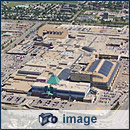
| | One of the most unlikely entertainment developments of the 1980s came with the building of Triple Five Corporation's West Edmonton Mall. The Ghermezian family who developed the Mall shrewdly sensed that for many people shopping can be a form of entertainment. In addition to attracting attention by making it the largest shopping centre in the world under one roof, they incorporated movie theatres, games arcades, rides, and a waterpark. West Edmonton Mall bucked the economic trend of the 1980s, opening Phase I in 1981, Phase II in 1983, and Phase III in 1985, although not without controversial tax concessions from the city and financing from the provincial government's Alberta Treasury Branches. By 1989 West Edmonton Mall was attracting nine million visitors a year. |
|
|
| | "In the late 1980s there were some signs of a modest economic recovery. Oil prices were up over $20, work on the Lloydminster heavy oil upgrader resumed, and the paper industry was healthy, with nine pulp mills operating in northern Alberta. City council felt confident enough to get rid of the 1950s city hall, which was overcrowded and had serious structural problems, and start work on a new one. A deal was worked out with Canadian National Railways to move their rail lines out of the city centre, opening a large area for redevelopment. The centrepiece of the former rail yards was a new downtown campus for Grant MacEwan Community College." |
|
|
| | None of these developments proved able to overcome the severity of the recession of the early 1990s. Edmonton's annual report for 1991 predicted a gradual rise in the price of crude oil to $23.00 over the next five years but instead it fell to $18.00 in 1992 and $13.75 in 1993 before starting to rise once again. Population growth in Edmonton stopped and economic activity as measured by building permits plummeted. A sign of the times was that in the mid-1990s the "Highlights" section of the city annual report stopped reporting population figures for the city and substituted a vague reference to the metro population of "about 850,000." The vacancy rate for downtown office space reached 18% in 1995. |
|
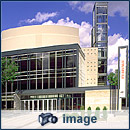
| | It was at this time as well that Edmonton began to dismantle its extensive array of city-owned utilities. The most high-profile of these moves to privatization was the sale of Edmonton Telephones to Telus (the former Alberta Government Telephones) in 1995. The transfer of the Municipal Airport to the Edmonton Regional Airports Authority the following year can be seen as part of the same process. The good news by 1994 was that the companies operating in the oil sands were discovering ways to be more efficient and reduce their costs so that they could make some money at these prices and a lot of money if they climbed back into the $20.00 range. Revived oil activity in the north combined with healthy agriculture and forest products sectors started to have their effect in 1996, and by 1998 a major national business group was forecasting that Edmonton would have the highest growth rate of any Canadian city in 1999. In that year the city's population grew rapidly for the first time in seven years. Another sign that Edmonton was beginning to pull out of the doldrums by the late 1990s was the opening of the magnificent Winspear Centre for Music in 1997, the culmination of a project that had started fund-raising a decade earlier. |
|
|
| | The discontents of the 1990s were nothing like as serious and prolonged as those of some earlier periods in the city's history, but many citizens of Edmonton were disgruntled by the fact that after outperforming Calgary in the 1970s, the rival city to the south had recovered faster and outpaced Edmonton in the 1990s. One of the missing elements that helped to account for Edmonton's slower growth in the decade was government spending. Since 1905 Edmonton as the capital had always been able to count on an irreducible minimum of spending on government, even in the dire circumstances of the Great Depression, and on expansion of government services in times of population growth and healthy revenues. |
|
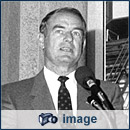
| | The billion dollar plus deficits of the later years of the Conservative government headed by Don Getty helped bring about his retirement and the new leadership of Ralph Klein in 1993. Klein had campaigned on a promise of deep cuts to government spending to bring the deficit under control. The cuts naturally affected Edmonton more than anywhere else in the province. When oil prices and government revenues started to revive in the mid-1990s, it seemed to many Edmontonians that, with the former mayor of Calgary in the premier's office, the lion's share was going south. It is too soon to say whether or not this perception was founded in fact and the necessary studies have yet to be done, but Premier Klein did not go out of his way to reassure Edmonton. Premiers from Calgary - Aberhart, Manning and Lougheed - had governed the province for most the period since 1935 but Ralph Klein was the first who declined to move his family to Edmonton and maintained only a nominal residence in the city. Relations between the premier and the capital remained cool even after the Conservative Bill Smith replaced Jan Reimer as mayor and Edmonton's constituencies returned a number of Conservatives in the 2001 provincial election. |
|
|
| | In spite of government cutbacks, Edmonton began the new millennium with its economy going full speed ahead. In 2001 the city hosted its third large international sporting event when the IAAF World Championships in Athletics were held in the city. On a smaller scale the FIFA Women's World Soccer Championship in 2002 drew large crowds and much positive international attention for the city. Among other important local institutions, both the Edmonton Oilers and the Edmonton Symphony ran into serious financial difficulties as a result of the hard economic times of the 1990s. Both managed to survive and put themselves back on track in the early years of the new millennium. In 2003, Edmontonians demonstrated once again that they had not lost their originality and drive when they put on the first outdoor NHL game at Commonwealth Stadium, an event that attracted fans from all over the world and a massive television audience... |
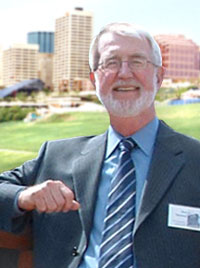 To mark the occasion of Edmonton's centennial, Dr. Rod Macleod of the University of Alberta has authored Edmonton's Story. Read this new history of the city to discover the words, images, and sounds of the Edmonton urban experience in all its diversity.
To mark the occasion of Edmonton's centennial, Dr. Rod Macleod of the University of Alberta has authored Edmonton's Story. Read this new history of the city to discover the words, images, and sounds of the Edmonton urban experience in all its diversity.




































































































